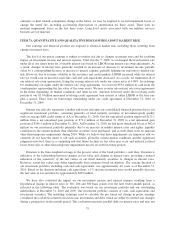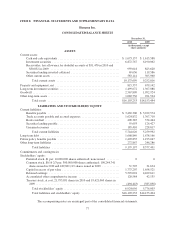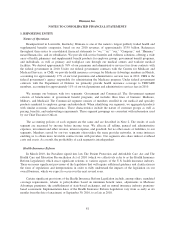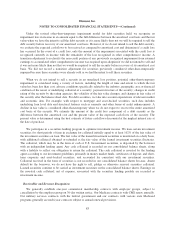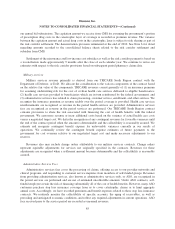Humana 2010 Annual Report Download - page 92
Download and view the complete annual report
Please find page 92 of the 2010 Humana annual report below. You can navigate through the pages in the report by either clicking on the pages listed below, or by using the keyword search tool below to find specific information within the annual report.Humana Inc.
NOTES TO CONSOLIDATED FINANCIAL STATEMENTS—(Continued)
2. SUMMARY OF SIGNIFICANT ACCOUNTING POLICIES
Basis of Presentation
Our financial statements and accompanying notes are prepared in accordance with accounting principles
generally accepted in the United States of America. Our consolidated financial statements include the accounts of
Humana Inc. and subsidiaries that the Company controls including variable interest entities associated with
medical practices for which the Company is the primary beneficiary. Generally, we do not own medical practices
but instead enter into exclusive long-term management agreements with the affiliated Professional Associations,
or P.A.s, that operate the medical practices. Based upon the provisions of these agreements, these affiliated P.A.s
are variable interest entities and we are the primary beneficiary, and accordingly we consolidated the affiliated
P.A.s. All significant intercompany balances and transactions have been eliminated.
The preparation of financial statements in accordance with accounting principles generally accepted in the
United States of America requires us to make estimates and assumptions that affect the amounts reported in the
consolidated financial statements and accompanying notes. The areas involving the most significant use of
estimates are the estimation of benefits payable, the impact of risk sharing provisions related to our Medicare and
TRICARE contracts, the valuation and related impairment recognition of investment securities, and the valuation
and related impairment recognition of long-lived assets, including goodwill. These estimates are based on
knowledge of current events and anticipated future events, and accordingly, actual results may ultimately differ
materially from those estimates.
Cash and Cash Equivalents
Cash and cash equivalents include cash, time deposits, money market funds, commercial paper, other money
market instruments, and certain U.S. Government securities with an original maturity of three months or less.
Carrying value approximates fair value due to the short-term maturity of the investments.
Investment Securities
Investment securities, which consist entirely of debt securities, have been categorized as available for sale
and, as a result, are stated at fair value. Investment securities available for current operations are classified as
current assets. Investment securities available for our long-term insurance product and professional liability
funding requirements, as well as restricted statutory deposits and venture capital investments, are classified as
long-term assets. For the purpose of determining gross realized gains and losses, which are included as a
component of investment income in the consolidated statements of income, the cost of investment securities sold
is based upon specific identification. Unrealized holding gains and losses, net of applicable deferred taxes, are
included as a component of stockholders’ equity and comprehensive income until realized from a sale or other-
than-temporary impairment.
In April 2009, the Financial Accounting Standards Board, or the FASB, issued new guidance to address
concerns about (1) measuring the fair value of financial instruments when the markets become inactive and
quoted prices may reflect distressed transactions and (2) recording impairment charges on investments in debt
securities. The new guidance highlighted and expanded on the factors that should be considered in estimating fair
value when the volume and level of activity for a financial asset or liability has significantly decreased and
required new disclosures relating to fair value measurement inputs and valuation techniques (including changes
in inputs and valuation techniques). In addition, new guidance regarding recognition and presentation of other-
than-temporary impairments changed (1) the trigger for determining whether an other-than-temporary
impairment exists and (2) the amount of an impairment charge to be recorded in earnings. We adopted the
provisions of the new guidance for the quarter ended June 30, 2009. Refer to Note 4 and Note 5.
82





